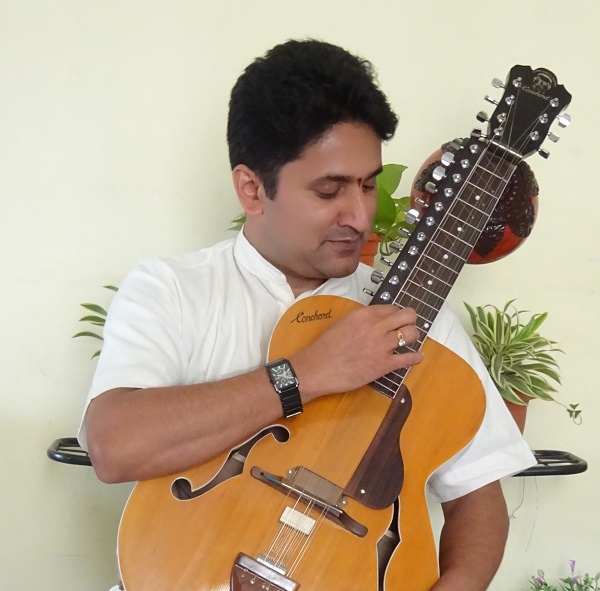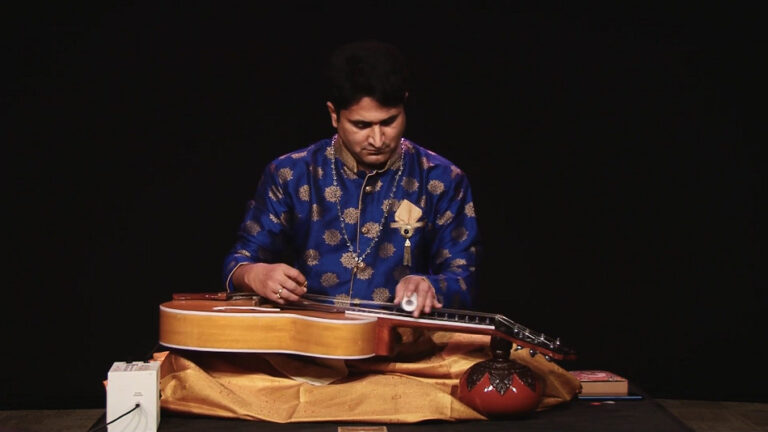Musician Sampagodu Vighnaraja has introduced a newer variant of slide guitar to Carnatic music. The Sumukha Veena is a variant of the lute family instruments, but with a different structure.
Indian music has adopted a bevy of western instruments. It was two centuries ago that Baluswami Dikshitar, brother of Muthuswami Dikshitar, introduced the western violin to Carnatic. Today, a Carnatic concert sans violin is almost unthinkable. Over the years, several such ‘alien’ instruments became part of south Indian classical music. Saxophone, mandolin, clarinet, guitar, the keyboard and many others were introduced with or without structural modifications.
The latest to join the pack is the Sumukha Veena, a fresh adaptation of the acoustic slide guitar. It has been introduced by Carnatic musician Sampadogu Vighnaraja, who has named the new instrument after his favourite deity, Ganesha (Sumukha). “There have been earlier adaptations of the slide guitar, such as the Mohan Veena and Chitravina. “Sumukha Veena is a variant of the lute family of instruments, but with a different structure,” says Vighnaraja.
The Sumukha Veena looks like a Mohan Veena. But the string arrangements and the playing techniques are different. The upper body of Sumukha Veena has Himalayan pinewood. The fingerboard is made of rosewood. It has six main strings aligned in s-p- sS- pP(capital letter indicating higher octave) order.
Strings and structure
The first string, closest to the body of the player, is the mandra shadja (one octave below the tonic note) and the second string is the mandra panchama. The third and fourth strings are aligned close to each other. They are to be played together. They are tuned to the mandra shadja (an octave below the tonic note) and adhaara shadja (tonic note) respectively.

The fifth and sixth strings are also aligned close to each other and are to be played together. They are tuned to mandra panchama and its higher octave panchama (5th note from the tonic note), respectively. “This dual octave string alignment is inspired from Chitravina,” says Vighnaraja. The Sumukha Veena also has 12 or 13 sympathetic strings that resonate when the main strings are plucked.
The instrument also has a resonator with a bridge on it, a smaller bridge on the neck of the fingerboard and a metal stick mounted on each of the bridges. The main strings pass through these metal sticks. This helps in bringing out a sharp sound that sustains. A wooden tail-piece attached on the extreme right of the instrument anchors the main strings. The fingerboard on which the fret lines are marked helps the player locate the positions of the notes accurately.
“Like the Chitravina, the Sumukha Veena also has a ‘koda’ (pot-like support that is attached behind the neck of the guitar; this does not work like a resonator). However, the Sumukha Veena does not have drone strings or chikaari. It has frets which are not directly used for playing, but are used only to indicate the positioning of the notes to help the player hit the correct notes,” explains Vighnaraja.
16 years in the making
Vighnaraja started his research on the instrument in 2005. “As a child, I was a fan of the Mandolin. But I couldn’t get one in Sringeri, where I was born and brought up. Later, when I shifted to Bengaluru, I bought one. But to my dismay, it was a folk Mandolin, which could not produce the gamakas in Carnatic music,” he says. “I raised the bridge with the neck of a broken pen. Using the other part of the same pen as a slider, I started playing it. Although the experiment was satisfactory, the sound was very feeble.
The problem was with the size of the instrument. This prompted him to experiment on a slide guitar that is much bigger than a Mandolin. “One metal slider was used as a bridge on the neck of the guitar and another to slide over the strings. I kept trying different sliders including glass and brass, and, at last, used a teflon slider. Later, Vighnaraja worked with Mridangam player A.V. Kashinath to improvise the instrument’s structure by attaching a ‘koda’ to it. Last year, during the Covid-19 lockdown, Ria Biswas, daughter of Kolkata-based Mohan Veena maker Baba Sindhu Biswas, helped him make the instrument.
The Sumukha Veena is played like a regular guitar using the plectrum or veena nakha striking away from the body of the player and also back and forth while playing the faster phrases. The teflon slider contributes to its soft sound. “As it is a modified acoustic slide guitar the sound is natural and majestic. Apart from the single strings, it also employs the concept of octave (two strings together) strings that enrich the sound of the instrument. The way plectrum is used has created an extra scope for fast phrases, apart from its ability to produce slow, subtle and melodious sound as well as robust sound,” says Vighanaraja.
That said, the journey wasn’t a cakewalk. “The biggest challenge was to get the crispness in the phrases that Carnatic music demands. Being a slide instrument, its tendency is for the oscillations to sound enhanced on every note. Limiting these oscillations was a huge task,” he says. “However, learning and exploring the possibilities was fun,” he beams.





1 Comment
Valuable information. Thank you